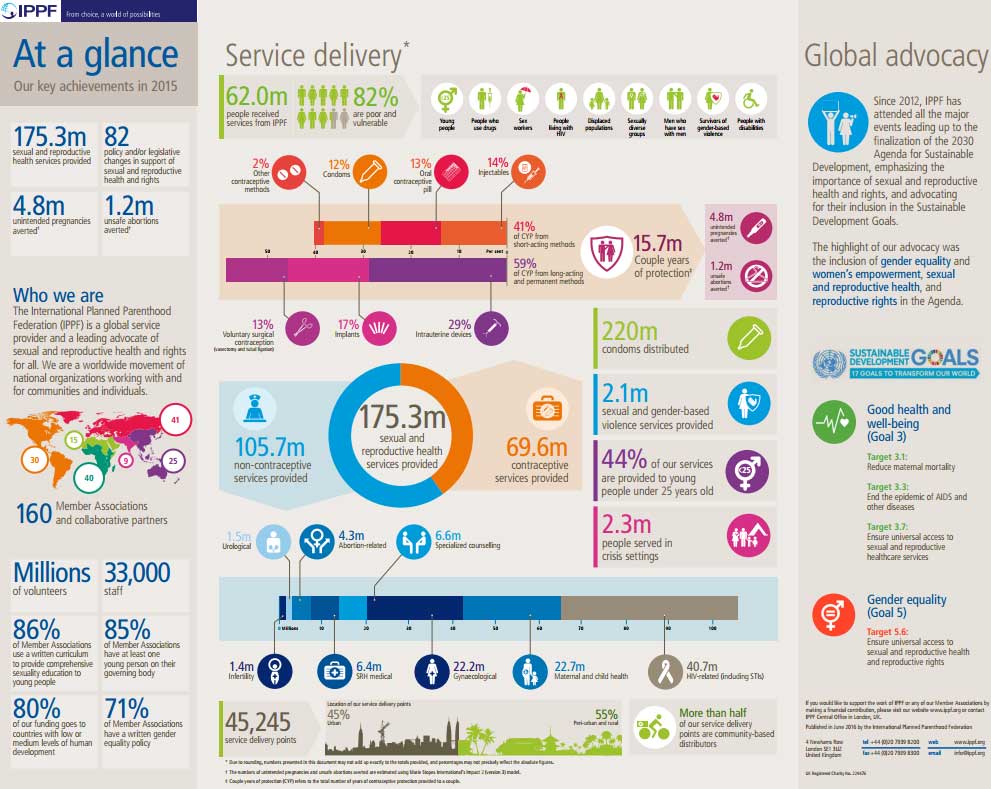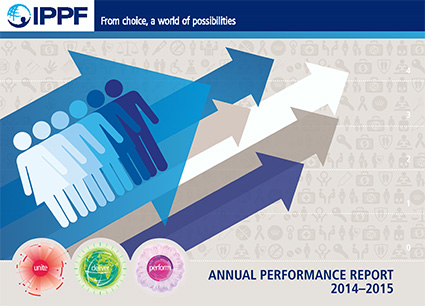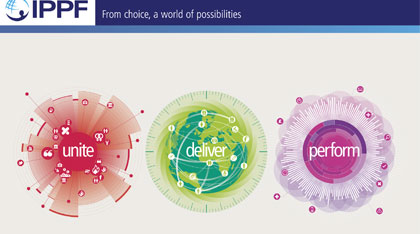
Women and children are disproportionately affected by natural disaster and war - pregnant women face dangerous deliveries and, in unprotected refugee settlements, rape, trafficking and gender-based violence increase. IPPF delivers essential lifesaving services for women, men and children in times of crisis.
Articles by Emergencies

What does it take to save a life?
Imagine this: You’re pregnant, living at home, expecting to give birth in a few weeks’ time with the assistance of staff at your local clinic. But then disaster strikes. It could be a typhoon, or a tsunami or conflict. You flee and then find yourself in a makeshift camp where nothing is certain anymore. Bad enough you’ve left everything you own behind. Bad enough you no longer feel safe – you can’t lock a tent door. But you’re relying on people who you don’t know for food – and people you may not trust for security. And how will you give birth? When you hear of populations dislodged, yout think of the immediate challenges of food and shelter. But what about contraception and neo-natal services? What about the dangers of sexual violence that women and girls in particular face? This is why IPPF’s humanitarian arm SPRINT was founded: to ensure access to essential Sexual and Reproductive Health and Rights services for women, men and children in times of crisis. In Syria 46,500 women will suffer gender based violence, including rape, as a result of the ongoing conflict. This shows a great need to ensure that the human rights of women and girls are protected and able to access sexual and reproductive healthcare. The Syrian Family Planning Association is in the front line when it comes to dealing with domestic-based violence – the less-reported consequence of every war. The kind of violence facing one of our clients, Amal. Amal had bruises on her face and was in a fragile state when she was admitted to the Al-Halbouni Health clinic. She had been severely beaten by her husband. The SFPA is committed to involving men to find lasting solutions to issues of gender based violence. Thanks to the integrated package of support services provided by Al- Halbouni clinic to her and her husband, Amal now feels safer. “I feel more aware of my rights, and I know how to find help when I need it,” she said. Women and girls are disproportionately influenced by humanitarian crises exposed to early marriage, trafficking, rape, forced pregnancies, unattended service delivery during complicated pregnancies and delivery. The statistics are shocking: 26 million of the 100 million people are in need of humanitarian assistance, are women and adolescent girls of reproductive age 500 of these women and girls die every day from complications related to pregnancy and childbirths 85 % of those displaced by the 2010 floods were women and children More than 75% of Syrian refugees who fled are women and children Women and girls are 14 times more likely to die in disaster settings than men 7 out of 10 women are exposed to gender-based violence in crises situations unfolding right now. These deaths and violence are preventable. We could stop it by putting money and efforts into an integrated comprehensive package on reproductive health into the standard humanitarian response. Progress in targeting women and girls has been achieved in the past decade. But sexual and reproductive health services are often neglected in humanitarian emergencies and still remain a less universally acknowledged priority. Over the last 10 years, IPPF has reached millions of people during floods, conflicts, earthquakes, cyclones. When health care often collapsed, our Member Associations continued to serve the unreachable, which make three quarters of IPPF clients. All IPPF approaches are bottom-up, that means we build local capacity before, during and after crisis strikes – often engaging young people during humanitarian crisis as peer-peer educators and providers. The good news is the guidelines are developed. We know what needs to be done. What we need now is action from many different stakeholders.

Combatting sexual violence and addressing family planning in a Ugandan refugee settlement
IPPF is an active member of the Population and Sustainability Network (PSN) which advocates for greater understanding of the relationships between population, health and sustainable development.The network is currently bringing a family planning component to a project combatting sexual violence in a Ugandan refugee settlement. UNHCR estimates show that there are currently around 250,000 refugees from the Democratic Republic of Congo (DRC) in Uganda. Around 60,000 live in the Rwamwanja refugee settlement, where a large proportion of women are rape survivors. For many of these women, escaping sexual violence as a weapon of war in the DRC is not the end of their ordeal, as levels of this form of violence in the settlement itself remain high. As a result, PSN Network member, the Thohoyandou Victim Empowerment Programme (TVEP), and the Population Council-led Africa Regional Sexual and Gender-Based Violence (SGBV) Network is providing technical assistance in Rwamwanja for the implementation of its model programme designed to combat violence against women. TVEP is experienced in implementing unique programmes that combat sexual and gender based violence. It’s empowerment projects are varied, from its community based “Zero Tolerance Village Alliance” programme combatting SGBV through workshops, support groups and infrastructural changes (such as the development of safe houses for SGBV survivors), to its Trauma Centres providing essential services to survivors of sexual assault. Evidence shows that implementation of TVEP’s model in other settings had led to enhanced knowledge among community members of where to obtain post-rape care services, an increase in women’s agency and to a change in negative gender beliefs. The programme in the Rwamwanja refugee settlement is working to combat four the thematic areas of sexual assault, child abuse, HIV stigma and domestic violence, and aims to empower community members with educational activities on their rights and responsibilities in these areas. Fiona Nicholson, TVEP Programme Director said, “TVEP joined the Population and Sustainability Network as we wanted to develop our work to have an additional focus on voluntary family planning. When we arrived in Rwamwanja we realised this project required that input.” From a family planning perspective, there are two primary issues needing urgent attention in Rwamwanja. Many of the refugees, having lost their entire families in the process of escaping the DRC, are keen to have large families but lack information on healthy timing and spacing of pregnancy. Additionally, with such high rape prevalence, it is important that women have access to emergency contraception at Rwamwanja’s health centres. David Johnson, PSN Chief Executive said, “We’re already working with TVEP at a South African site, where we are providing the community information, education and communication materials and training on healthy timing and spacing of pregnancy, and we were only too happy adapt those materials for this different setting and add a greater focus on emergency contraception options.” The global refugee crisis is currently gaining a great deal of coverage, but the focus is mainly on refugees seeking sanctuary in Europe. All the organisations involved at Rwamwanja are all too aware that the crisis is in no way restricted to Europe and that the sexual and reproductive rights of all refugees must never be forgotten.

IPPF - UN MOUVEMENT POUR LE CHANGEMENT
Le cadre stratégique 2016–2022 constitue une vision à la fois audacieuse et ambitieuse des projets de l’IPPF, la Fédération internationale pour la planification familiale, et des moyens de les concrétiser au cours des sept prochaines années. Approuvé en novembre 2014 par le Conseil de gouvernance de l’IPPF, la plus haute instance décisionnelle de la Fédération, ce cadre représente l’aboutissement d’un vaste processus consultatif sollicitant la collaboration d’associations membres, de partenaires et de bailleurs de fonds à l’échelle mondiale. Notre stratégie répond aux tendances sociales, politiques et démographiques qui se manifestent dans le monde entier. Ces tendances peuvent se résumer ainsi: les attentes et le potentiel de la génération la plus nombreuse de jeunes de tous les temps; de profondes inégalités sociales et économiques persistantes, et notamment la discrimination contre les filles et les femmes; ainsi que l’opposition qui menace les avancées réalisées dans le domaine des droits humains. Ce cadre s’appuie aussi sur des évaluations et des analyses de notre travail: nos forces et faiblesses, nos capacités, nos ressources et nos réseaux. Le cadre stratégique de l’IPPF établit les priorités qui permettront à la Fédération d’avoir de l’impact en tant que mouvement axé sur la santé et les droits sexuels et reproductifs (SDSR) au cours des sept années à venir. Il guidera les associations membres nationales et leurs partenaires en vue d’élaborer des stratégies spécifiques à leurs pays, en fonction de leurs ressources et adaptées pour se mettre au service des groupes les plus marginalisés sur le plan local. Il apporte aussi au Secrétariat un axe d’action quant à son influence internationale et dans son soutien aux associations membres. Les associations membres seront tenues de rendre compte de leurs résultats une fois par an, qui seront compilés dans un tableau de bord mondial pour mesurer les progrès de la mise en pratique du cadre stratégique. En se dotant de cet outil essentiel, l’IPPF se donne les moyens d’aller de l’avant et de tenir ses promesses. En tant que chef de file du mouvement sur la santé et les droits sexuels et reproductifs, nous aiderons à unir les actions et les accomplissements de défenseurs de la SSR dans le monde entier, afin de changer de manière radicale la manière dont la santé et les droits sexuels et reproductifs sont appréhendés dans le monde entier.

At a Glance 2014
Key facts and figures highlighting IPPF's achievements in 2014.

Annual Performance Report 2014-15
2014 was our third year implementing IPPF’s three Change Goals – Unite, Deliver and Perform. We have monitored the trajectory of our growth in performance to date, and are already seeing remarkable success in all three areas, as presented in our Annual Performance Report 2014-2015. Member Associations and collaborative partners in 55 countries contributed to 81 changes in policy or legislation that support or defend sexual and reproductive health and rights. At the regional and global levels, IPPF’s advocacy contributed to 18 changes, of which 12 were advances in safeguarding sexual and reproductive health and rights in the post-2015 development framework. With the delivery of 149.3 million services in 2014, we are on track to achieve our ambitious target of doubling the number of sexual and reproductive health services provided between 2010 and 2015. Over eight in ten clients who accessed services were poor and vulnerable, while almost half of our services went to young people. IPPF’s achievements in 2014 contribute to a strong performance culture where decisions are based on data, organizational learning happens at all levels, technical support is provided to increase effectiveness, and investments are made to support communities most in need.
At a Glance 2013
Key facts and figures highlighting IPPF's achievements in 2013. IPPF provided 136.6m sexual and reproductive health services and averted 580,000 unsafe abortions.

Annual Performance Report 2013-14
2013 was our second year implementing IPPF’s three Change Goals – Unite, Deliver and Perform. We have monitored the trajectory of our growth in performance to date, and are already seeing remarkable success in all three areas, as presented in our Annual Performance Report 2013-2014. Member Associations in 66 countries contributed to 97 changes in policy or legislation that support or defend sexual and reproductive health and rights. At the regional and global levels, IPPF’s advocacy contributed to 13 changes, of which ten were advances in safeguarding sexual and reproductive health and rights in the post-2015 development framework. With the delivery of 136.6 million services in 2013, we are on track to achieve our ambitious target of doubling the number of sexual and reproductive health services provided between 2010 and 2015. Eight in ten clients who accessed services were poor and vulnerable, and for the first time ever, almost half of our services went to young people. IPPF’s achievements in 2013 contribute to a strong performance culture where decisions are based on data, organizational learning happens at all levels, technical support is provided to increase effectiveness, and investments are made to support communities most in need.
At a Glance 2012
Key facts and figures highlighting IPPF's achievements in 2012. IPPF provided 112.7m sexual and reproductive health services and averted 550,000 unsafe abortions.
At a Glance 2011
Key facts and figures highlighting IPPF's achievements in 2011. IPPF provided 89.6m sexual and reproductive health services and averted 710,000 unsafe abortions.

Annual Performance Report 2011-12
2012 is IPPF’s 60th year. The Annual Performance Report confirms, once again, IPPF’s vital role in human development. It opens with an overview of the external challenges that threaten sexual and reproductive health and rights (SRHR). Despite these challenges, IPPF continues to deliver impressive results. In 2011, Member Associations contributed to 116 policy and/or legislative changes in support or defence of sexual and reproductive health and rights (SRHR). The Federation as a whole provided 89.6 million SRH services with the majority going to the poor and vulnerable, including young people. Robust systems and processes have ensured that money has been invested cost-effectively where it is most needed.







